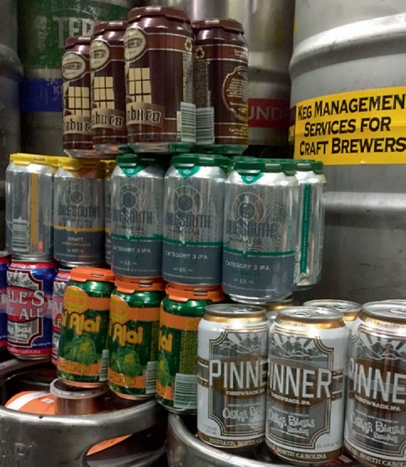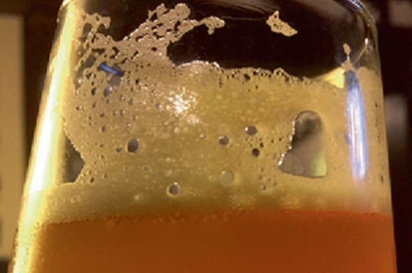Beer Myths Down the Drain
Over thousands of years of beer history, many myths have surfaced about beer. It’s time to dispel these silly beer fairytales.
MYTH #1. Canned beer doesn’t taste as good as bottled beer.
Canned beer is actually better for beer than bottles and results in a fresher product.
Glass allows light to come into contact with the beer and ultraviolet light is one of the leading contributors to the deterioration of beer. The light “skunks” the beer by negatively affecting the natural compounds in hops and creates an off-putting aroma. Although darker green or brown bottles are better than clear, cans are still the best because no light comes into contact with the beer.
The second and biggest concern with packaged beer is oxygen levels. In bottled beer, the small amount of headspace above the liquid can have levels of oxygen, oxidizing the beer and making it stale. With cans, the top of the can is seamed directly on top of the liquid, which minimizes oxygen levels.
For those naysayers who believe canned beer tastes “metallic” because of the aluminum — well, it’s in their heads. A lining in all cans keeps the beer from coming into direct contact with the metal.
Oskar Blues, the first craft brewery to can their beers, offer all of their products in either cans or draft — no bottles. Since Oskar Blues made it OK to can, many local breweries have begun offering their beers in cans, too. Cigar City Brewing, Due South Brewing, Brew Bus Brewing, Intuition Ale Works, Swamp Head Brewing, Jdub’s Brewing, Miami Brewing Company, to name a few, all sell their beers in cans. They’re perfect for Florida and won’t shatter next to the pool.
MYTH #2. Dark beer is “heavier” than lighter-colored beers.
The color of the beer has nothing to do with how heavy a beer is.
Although there are heavier beers that are dark, like imperial stouts, scotch ales and Belgian quads, this doesn’t mean all dark beers are heavy. The color of the beer generally comes about with the addition of darker roasted malts (for certain Belgian beers, dark candy sugars contribute to the dark color). A beer is generally considered heavy when it has a high level of alcohol or a lot of residual sugar that makes it sit heavy on the palate.
Some delicious dark beers are actually very light and easy drinking. German Schwarzbiers, or black beers, are lagers brewed with debittered black malt. These are crisp, light, refreshing lagers with a black color giving it a mild roasty flavor. Uinta Baba and Shiner Black Lager are two great examples. Dry Irish stouts also use dark roasted malt to make this ale as black as midnight. They’re regularly served on nitrogen, giving a creamy mouthfeel, which makes people think it’s heavier than actually it is. Guinness is low in alcohol and calories, which surprises some folks. Another Irish stout, Cigar City Patio Tools, is easy to throw back.
On the other side of this argument are some Imperial pilsners, Belgian golden strong ales, imperial IPAs, wheat wines or barleywines. You’ll have a much lighter-colored beer with a much higher level of alcohol and a heavier flavor by comparison.
MYTH #3. Draft beer tastes better than packaged beer.
Everyone loves seeing a fresh beer being poured off tap at your local watering hole. But that doesn’t mean the beer is going to taste better than out of a bottle or can.
Proper storage and fresh product generally result in the best experience. If a brewery has a quality packaging and kegging setup and they package the beer in kegs and bottles/cans the same day, ship them out simultaneously and keep the beer refrigerated along the entire distribution chain, both beers should taste the same.
Beer deterioration can happen as beer ages or if it is warmed up dramatically. Kegs are generally cared for better, but a good retailer or distributor will keep their beer climate controlled and refrigerated.
If a retailer doesn’t clean their draft lines regularly, you’ll sometimes have draft beer tasting much less fresh than its bottle or can counterpart.
In either scenario, make sure you’ve got a clean glass. Otherwise, your beer will taste “off” regardless of where it is poured from.
MYTH #4. Beer should be served ice cold.
If you like the actual taste of beer, you’ll want it to warm up a little bit.
Any ice-cold refreshment will subdue flavors and numb your taste buds to a certain extent. It’s almost a waste to drink a beautifully crafted Belgian style or big barrel-aged beer at 38 degrees.
As beer or other foods and beverages warm up, they release more flavors, allowing you to taste more. It’s the same reason artisan cheeses are served at room temperature.
Like red wines and white wines, each style of beer has an optimal recommended drinking temperature. For example, a pilsner should be served much colder than an English mild or barleywine. It’s a common myth that the English drink their beer warm. They serve cask beers and other English styles at the proper serving temperature, which is much warmer than “ice cold.”
The Beer Judge Certification Program Style Guidelines and Beer Advocate are both great references for recommended serving temperatures.
MYTH #5. Foam on beer is bad.
A big, pillowy head on a beer is representative of a properly crafted beer served at the right temperature.
A quality beer should leave a line on the side of a clean glass, marking each sip you take. This is called lacing.
A beer served too cold will not produce a quality head either, because the CO2 stays in solution at colder temperatures.
When you pour a beer, you want a proper pour, creating an optimum 1-1.5” of head in most American styles (many Belgian styles will produce a bigger head). Hold the glass at an angle. Begin by pouring down the side of the glass. As you get a few ounces into the glass, slowly straighten the glass and pour the beer down the center of the glass directly into the liquid at the bottom. This will carouse the beer, releasing CO2 and all of those delicious flavors and aromas, while creating a beautiful head.
Just remember next time you’re in the midst of a “bargument” that beer is a complex beverage. It might require some research before spreading beer rumors.







